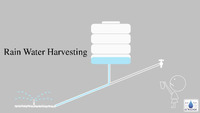Items
Tag
Groundwater recharge
-
 Rain Water Harvesting Rainwater harvesting is a method of collecting and utilizing rainfall where it falls to minimize waste. It serves multiple purposes, including providing drinking water, irrigation, enhancing groundwater recharge, and reducing urban flooding. Key techniques include capturing rooftop runoff and seasonal floodwaters, using systems like storage tanks and recharge wells. Effective rainwater management depends on understanding local rainfall patterns and implementing structures to filter and store water. While costs can be substantial, especially for groundwater recharge systems, the benefits of sustainable water supply and reduced environmental impact make it a valuable practice in water-scarce areas.
Rain Water Harvesting Rainwater harvesting is a method of collecting and utilizing rainfall where it falls to minimize waste. It serves multiple purposes, including providing drinking water, irrigation, enhancing groundwater recharge, and reducing urban flooding. Key techniques include capturing rooftop runoff and seasonal floodwaters, using systems like storage tanks and recharge wells. Effective rainwater management depends on understanding local rainfall patterns and implementing structures to filter and store water. While costs can be substantial, especially for groundwater recharge systems, the benefits of sustainable water supply and reduced environmental impact make it a valuable practice in water-scarce areas. -
 Accumulation and Movement of groundwater The Advanced Center for Water Resources Development and Management (ACWADAM) focuses on understanding aquifers, which are crucial for groundwater recharge and discharge. Aquifer catchments are areas that recharge groundwater, while commands are discharge areas. Groundwater movement is influenced by water table elevation and pressure, requiring measurement of water levels. Recharge areas show diverging flow lines and fluctuating water levels, while discharge areas exhibit converging flow lines and stable water levels. Additionally, the relationship between watersheds and aquifers is complex, as one aquifer can span multiple watersheds, and vice versa, influencing both influent and effluent streams.
Accumulation and Movement of groundwater The Advanced Center for Water Resources Development and Management (ACWADAM) focuses on understanding aquifers, which are crucial for groundwater recharge and discharge. Aquifer catchments are areas that recharge groundwater, while commands are discharge areas. Groundwater movement is influenced by water table elevation and pressure, requiring measurement of water levels. Recharge areas show diverging flow lines and fluctuating water levels, while discharge areas exhibit converging flow lines and stable water levels. Additionally, the relationship between watersheds and aquifers is complex, as one aquifer can span multiple watersheds, and vice versa, influencing both influent and effluent streams.